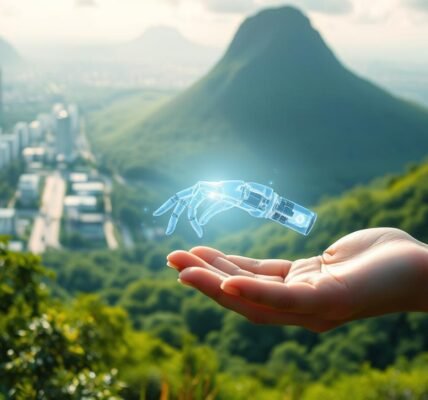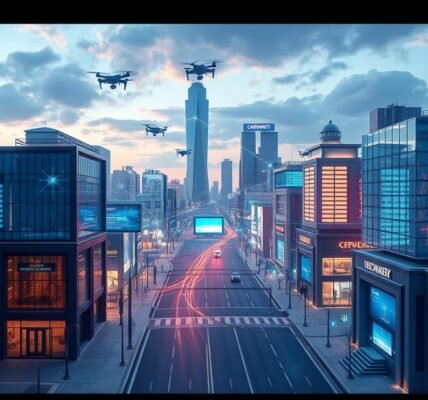How is AI being used to combat climate change and environmental challenges?
“The greatest threat to our planet is the belief that someone else will save it.” – Robert Swan. This quote highlights the urgent need for action against climate change. Artificial Intelligence (AI) is now a key player in this fight. It’s changing how we tackle environmental challenges.
AI can quickly go through huge amounts of climate data. This helps us make better decisions to lessen environmental harm. It also makes renewable energy like wind and solar more efficient by understanding weather patterns. Plus, AI helps us keep an eye on the environment. It uses satellites and sensors to track deforestation and predict disasters, helping us act fast1.
AI is not just new and cool; it’s crucial. It helps manage resources and cut down on carbon emissions in many sectors. For example, Google uses AI in its data centers to reduce cooling energy use by 40%. This shows how AI can make a real difference in fighting climate change1.
For more on AI and climate action, check out this article.
Key Takeaways
- AI is key for analyzing big climate data to make better policies.
- It makes renewable energy more efficient and effective.
- AI can predict and prevent environmental disasters.
- It helps reduce the carbon footprint of industries.
- AI is showing big wins in making our planet more sustainable.
Introduction to AI and Climate Change
Climate change is a big challenge for our planet, affecting ecosystems, economies, and health. We need new solutions to fight these environmental threats. Artificial intelligence is a key tool, helping us predict, analyze, and manage climate issues better. As AI gets better, it helps us use energy smarter and work towards a more sustainable future.
AI systems are vital in finding ways to cut down on greenhouse gases and use more renewable energy. For example, AI can predict wind power 36 hours ahead, making wind energy more efficient2. It also helps place solar panels in the best spots to catch the most sunlight3. Big companies like Google use AI to make their data centers use less energy, showing AI’s role in lowering emissions3.
AI also helps spot areas at risk from climate disasters and helps plan how to protect them. By looking at big data, AI can forecast floods and wildfires, helping us prepare and lessen the effects of climate change4. The mix of AI and fighting climate change offers a big chance for a better future. It’s important for experts, policymakers, and environmental groups to work together to use AI well. For more info, check out AI and Climate Change Course.
The Role of AI in Global Climate Initiatives
Understanding how AI helps with global climate efforts is key. AI is more than a tool; it changes how we analyze data and manage resources. This leads to better care for our planet. For example, Google’s Flood Hub has helped millions by predicting floods, helping us fight climate disasters5. Also, AI in navigation has cut down CO2 emissions by over 2.4 million metric tons in recent years5.
The United Nations Sustainable Development Goals (SDGs) show how vital AI is for meeting climate goals. Many groups are working together to use AI for sustainable actions. This has led to less greenhouse gas emissions6. AI helps make buildings and roads better and greener. Researchers are looking into how AI can reduce carbon emissions in building projects, a big source of emissions7.
Working together across different areas shows how AI can tackle climate change and help everyone. This way, we’re not just solving today’s problems but also building a future where being green is the norm.
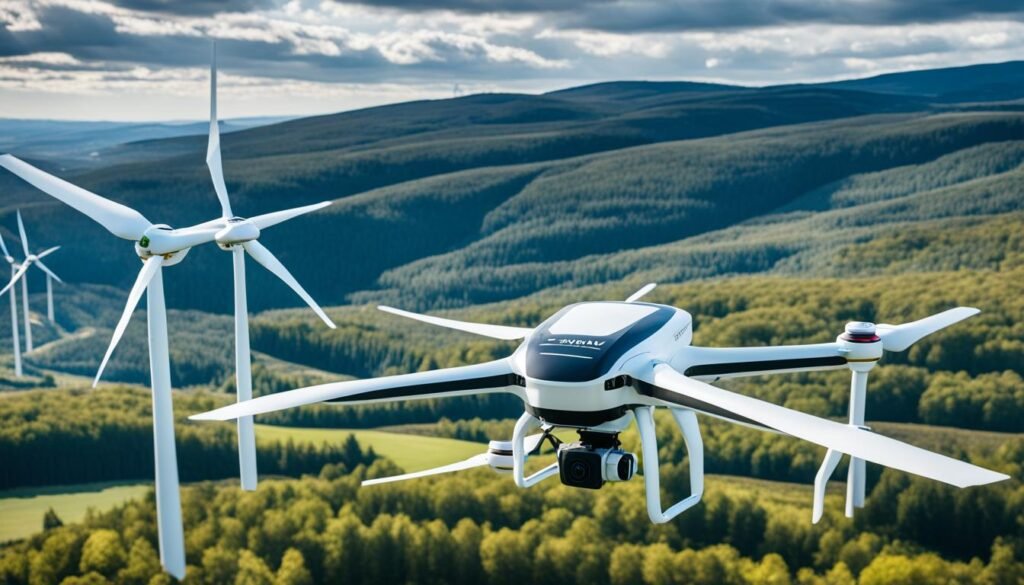
AI for Climate Change Solutions
AI has a big role in fighting climate change. It helps us use big data to understand and predict climate changes. For example, the Bezos Earth Fund gave $100 million to the AI for Climate and Nature Grand Challenge8. This money will help make technology that saves nature and improves power grids.
Understanding AI’s Potential in Mitigation Efforts
AI is making a big difference in solving climate change problems. This year, tech companies will make $184 billion from AI, showing it’s a growing field9. AI can cut down on greenhouse gases by 5% to 10%, which is a big help for the environment9. It also helps make cities better by managing traffic to cut down on pollution9.
Integration with United Nations Sustainable Development Goals
Using AI with the United Nations Sustainable Development Goals is key to a better future. At the 2023 United Nations Climate Change Conference in Dubai, we’ll see how AI helps with things like managing water and farming10. This event brings people together to use AI for good, like saving resources and making tech use more efficient10. I think working together and using technology wisely can lead to big steps forward in being sustainable.
| Area of Focus | Potential AI Contributions |
|---|---|
| Biodiversity | Monitoring wildlife and ecosystems, aiding conservation efforts |
| Energy Efficiency | Optimizing renewable energy usage and reducing waste |
| Agriculture | Enhancing crop yield while minimizing resource use |
| Urban Planning | Utilizing data for sustainable city development and resource management |
By using climate change mitigation AI, we’re working together towards a better future. These efforts will lead to a balance between technology and nature.
Machine Learning Algorithms for Environmental Sustainability
Machine learning is key in fighting for our planet’s future. It looks at big data to find trends that help us fight climate change. With eco-friendly AI, we can make better climate predictions. This helps leaders make strong plans to fight climate change11.

Machine learning helps make energy use better, changing how we use energy in buildings. AI can make energy use go down by 12% to 22% in the U.S12.. It also helps with traffic, making cars emit less pollution12.
AI also helps communities by watching over the air we breathe. It looks at industrial activities to cut down on pollution. This makes our ecosystems healthier12. These examples show how important machine learning is for a greener future.
| AI Applications | Impact on Environment |
|---|---|
| Energy Management | Up to 22% reduction in energy use |
| Traffic Optimization | Lower vehicle emissions |
| Pollution Monitoring | Enhanced air quality management |
| Wildlife Tracking | Support for conservation efforts |
Machine learning in AI has huge potential for the environment. It helps us save resources and supports our planet’s long-term health1113. I’m excited about these advances and how they can solve big environmental problems.
Predictive Modeling for Climate Patterns
AI technology is changing how we handle climate adaptation, especially with predictive modeling. This helps us understand climate patterns better. Global climate models are key for predicting future climate changes14. Over the last 50 years, tech advances like supercomputing and machine learning have made climate models better14. Now, with “global storm resolving models” (GSRMs), we can simulate weather with high detail, giving us a clear view of complex weather patterns14.
Improving Forecast Accuracy
Getting climate forecasts right is crucial for being ready for environmental changes. AI could cut global greenhouse gas emissions by 5% to 10% by 2030, helping fight climate change15. Machine learning can predict extreme weather, helping with evacuations and protecting buildings15. Even though GSRMs are costly, they can train ML emulators for quick and accurate climate simulations14.
Data-Driven Decision Making
Using AI in analyzing data helps make better decisions, which is key for climate resilience. Working with top climate modeling centers is vital for improving predictive modeling14. Better managing energy grids can predict energy needs and use more renewable sources, lowering environmental harm15. Tools like IBM’s Watson use machine learning to forecast energy from renewables, helping us plan better15.
| Technique | Description | Benefits |
|---|---|---|
| GSRMs | Fine grid climate models with advanced resolution | Detailed climate predictions and storm simulations |
| Machine Learning Algorithms | Automated analysis of climate data | Enhanced forecast accuracy and extreme weather predictions |
| AI-Optimized Energy Grids | Systems that manage energy production and consumption | Efficient integration of renewable energy and reduced emissions |
These methods not only make forecasts more accurate but also support a thorough, data-driven fight against climate change14.
Agricultural Innovations Powered by AI
Agricultural innovations led by AI are changing the game, making farming more sustainable. With the world’s population set to hit 9.7 billion by 2050, finding ways to produce food sustainably is key16. AI is crucial in meeting these needs and fighting climate change challenges.
Enhancing Crop Management
AI is now a big part of how we manage crops. It looks at soil health, weather, and what crops need. This leads to better farming with drones and predictive analytics, making more food and wasting less resources16. For example, John Deere’s See & Spray system cuts herbicide use by up to 90% in cotton fields, saving money and the planet16.
Optimizing Water Resource Usage
AI is also key in using water wisely, which is vital as water gets scarce. Chatbots give farmers advice on using water and fertilizers wisely, cutting down waste and harm to the environment16. Digital Green’s work has helped over 6 million farmers, showing how tech can make farming better and more sustainable17.
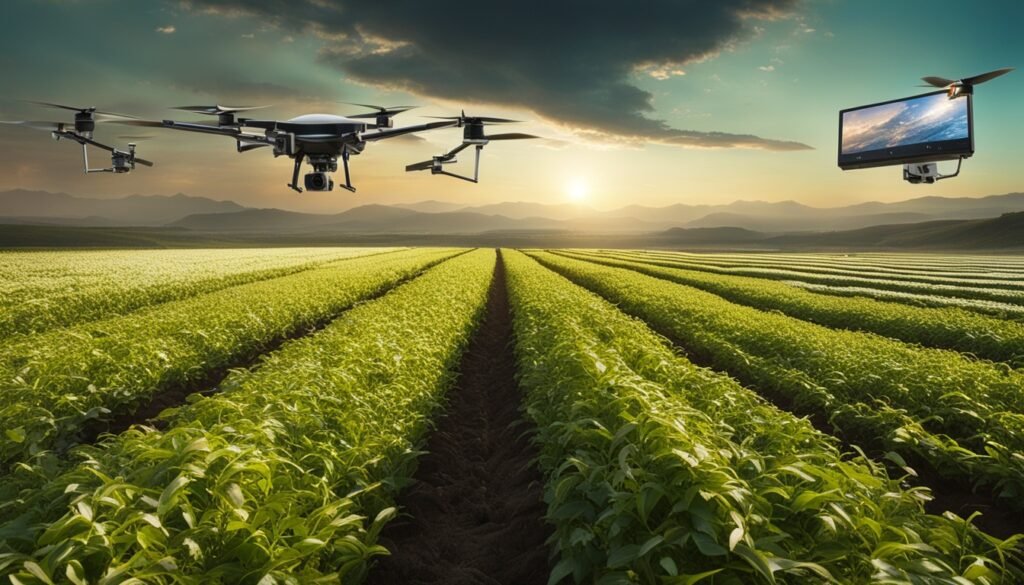
AI in Renewable Energy Optimization
Today, making renewable energy more efficient is key to fighting climate change. Artificial Intelligence (AI) helps a lot by making energy production and distribution better. With AI, we can manage renewable energy systems better, produce more energy, and cut down on harmful emissions.
Maximizing Efficiency of Energy Production
AI algorithms are super useful for predicting energy needs and changes. This helps manage energy grids better, making sure we use solar and wind power fully. For example, Google’s DeepMind AI boosted energy production by 20% at a wind farm by predicting wind conditions 36 hours ahead18. Also, machine learning helps analyze how much energy we use right now, making energy use more efficient across different areas19.
Reducing Carbon Footprint with AI
AI is changing how we work on reducing carbon emissions. It helps make carbon capture and storage better and finds the best places to store CO2 for a long time20. AI also tracks how climate change affects us and checks how well we’re saving energy, which is key for a green future19. With AI, we’re moving towards a future with less carbon, where clean energy will be worth over $75.82 billion by 203018.
Smart Technology for Climate Change Mitigation
Today, smart technology is key in fighting climate change in cities. By using advanced AI, cities can get better at being green.
In Singapore, AI helps manage traffic signals, cutting down travel time by 22% and reducing CO2 emissions21. This tech saves energy and makes cities more resilient to climate issues.
Also, AI helps protect coral reefs through partnerships like Microsoft and The Nature Conservancy21. AI finds new ways to fight climate change and protect our planet.
With over 50 AI sensors, Dryad detects forest fires early, helping fight climate disasters21. Innovators are changing how we tackle environmental threats.
Companies like Appen aim for net zero emissions by 2030, showing the private sector’s commitment to sustainability21. Eco-friendly AI is also seen in studies on renewable energy and LED lighting, like in the Philippines. Over 23,000 companies support sustainable business through the United Nations Global Compact21.
Smart tech is crucial for fighting climate change in cities. Cities using these technologies improve efficiency and move towards sustainable living.

| Technology | Impact | Example |
|---|---|---|
| AI in Traffic Management | Reduced travel time and emissions | Singapore’s traffic signal optimization |
| AI Sensors for Forest Fires | Early detection of wildfires | Dryad’s installations |
| AI in Coral Reef Conservation | Mapping and monitoring coral health | Microsoft and The Nature Conservancy |
| Corporate Sustainability Commitments | Achieving net zero emissions | Appen’s initiatives |
Tracking Urban Pollution with AI
Tracking urban pollution is key to better health and sustainable cities. AI helps cities keep an eye on pollution levels. It also gives important data for making decisions to improve air quality.
Improving Public Health Measures
AI helps create accurate air quality networks. It makes sense of signals from sensors. This is crucial because bad air quality causes about 5.5 million deaths worldwide each year22. AI helps predict pollution, so cities can warn people at risk.
Enhancing Urban Planning and Sustainability
AI in urban pollution tracking helps with sustainable city planning. It uses data from sensors and satellites to make pollution maps23. Governments working together to monitor air quality are key to fighting pollution’s health effects23. AI also helps use resources better in city projects, making sure they’re sustainable.
Disaster Prevention and Recovery with AI
AI is changing how we tackle risks from natural disasters. Over the last 50 years, disasters have increased a lot, causing more economic losses24. In 2018, over 108 million people needed help after natural disasters. This number could go up by nearly 50 percent by 2030, costing about USD 20 billion24.
AI is key in improving how we manage disaster risks. For example, an AI model can predict where and how bad floods will be better than old methods24. Google tested its AI flood warning in India’s Patna region in September 2018, its first alert24.
Using machine learning can help predict severe weather better, reducing risks from floods and other disasters2425. The U.S. Emergency Alert System often uses radio and cell phones, but these might not always reach everyone. This shows we need better ways, like AI24.
In India, the Ministry of Earth Sciences uses AI and machine learning to analyze detailed images. This helps make more accurate forecasts and improves disaster response24. After Hurricane Harvey, AI showed its value by helping reduce damages to $125 million, proving its worth25.
AI can help make disaster management better by speeding up responses and using resources wisely during crises. Disaster management teams are now using AI to predict disasters more accurately. This makes their plans better24. For example, AI models during Hurricane Harvey managed traffic well, showing how AI can help in disaster management25.

AI-Driven Climate Action in the Fashion Industry
The fashion industry is moving towards AI-driven climate action to tackle its big environmental impact. Fast fashion, in particular, is a major polluter, making up 10% of global emissions and using 60% of all plastic. It also causes 20% of industrial water pollution, showing the need for change26.
AI technologies are stepping up to help, promoting sustainable fashion and making operations more efficient.
Reducing Emissions in Fast Fashion
Fast fashion is expected to increase emissions by 60% in the next six years, making quick action necessary26. Big names like H&M are setting goals to cut emissions by 56% by 2030 and use 100% renewable energy27. AI is becoming a key tool to help companies meet these goals, improving how they manage inventory and streamline supply chains.
Promoting Sustainable Practices
Brands using AI can find new ways to make money and follow sustainability rules. A study found that over 211 managers in Bangladeshi garment factories using AI saw better emissions and energy use27. These technologies help companies cut emissions and lead the way in sustainable fashion, making the industry more eco-friendly. AI offers big solutions for the industry’s environmental issues26.

AI’s Role in Food Security and Agriculture
With changing weather patterns, ensuring everyone has enough food is a big global challenge. AI in farming is key to solving these issues. It helps make farming more efficient and cuts down on waste. This is crucial for sustainable farming.
Environmental factors make it hard to get food to everyone. So, new tech in farming is a must.
Smart Solutions for Environmental Challenges in Food Production
About half of the 821 million hungry people are farmers, showing how important farming tech is28. AI helps with many farming tasks, like predicting crop yields and saving resources. This leads to more reliable food systems28. For instance, Microsoft’s FarmBeats uses drones and sensors to improve farming, making it more efficient28. The agricultural AI market is expected to grow to $2.6 billion by 2025, showing more people are investing in this area29.
Minimizing Waste through AI Technologies
Less food waste is key to better food security. The U.S. sees over 70 foodborne illness outbreaks a month, highlighting the need for better quality control29. AI in farming can tackle these safety issues and help the planet. It uses AI and machine vision to quickly spot defects and contaminants, ensuring safer food29. Hybrid AI models can also predict food safety problems, showing AI’s potential to protect our food supply29.

| Year | Investment in Agricultural AI | Projected Market Growth |
|---|---|---|
| 2020 | $67.9 billion globally | $2.6 billion (by 2025) |
| 2023 | Expected increase in AI research publications | AI driving 10.3% higher GDP in the UK (equivalent to around $317 billion USD) |
Looking ahead, using AI for food security will help tackle environmental issues and make farming better292830.
Early Warning Systems Enhanced by AI
Artificial Intelligence (AI) is changing how we handle early warnings, especially for extreme weather. These systems are key for getting communities ready for climate challenges. In East Africa, the UN World Food Programme, Oxford University Physics Department, and national weather agencies are working together. They’re using AI and physics to improve weather forecasting31.
This effort is making rainfall forecasts more accurate, which is crucial in areas where old methods often don’t work31.
Predicting Extreme Weather Events
Extreme weather events are happening more often and getting worse because of climate change. The floods in East Africa after a severe drought show we need better forecasting31. AI is filling in the gaps left by traditional forecasting, setting a new standard.
This tech gives accurate early warnings and is seen as a game-changer for managing disaster risks31.
Community Resilience Building
Building community resilience is key to reducing the effects of climate disasters. AI early warning systems help communities get ready for weather events. This means better use of resources and strategies to lower risks, protecting lives and jobs.
Regional climate centers like ICPAC are helping 11 member states build their capacity31. As these systems work well in East Africa, they’re setting a standard for other areas with similar climate issues31.

Governments and AI Policies for Climate Mitigation
AI policies are key in fighting climate change. They help use artificial intelligence to tackle climate issues. Governments need to create rules that make sure AI is used right for the planet.
Working together is crucial. Governments, schools, and businesses must join forces. Each group has its own view on how to solve climate problems. This teamwork can lead to AI systems that handle big data and give useful advice. This helps make better decisions and invest in projects that make our future safer for success.
Putting money into building things that can withstand climate change pays off quickly in risky areas32. Studies show adding just 3% more to a project can bring back $4 for every $1 spent32. This shows how AI can help governments make the most of their climate efforts without costing too much.
AI is also great for tracking climate change from space. It helps keep an eye on how the planet is doing. This lets us act fast when the environment changes33. AI can also make switching to clean energy easier, helping us reach goals for affordable, clean energy by 203034.
It’s important for policymakers to keep up with AI and climate change. They need to make sure AI policies are flexible and forward-thinking. This way, governments can lead the fight against climate change and help create a better future for everyone.
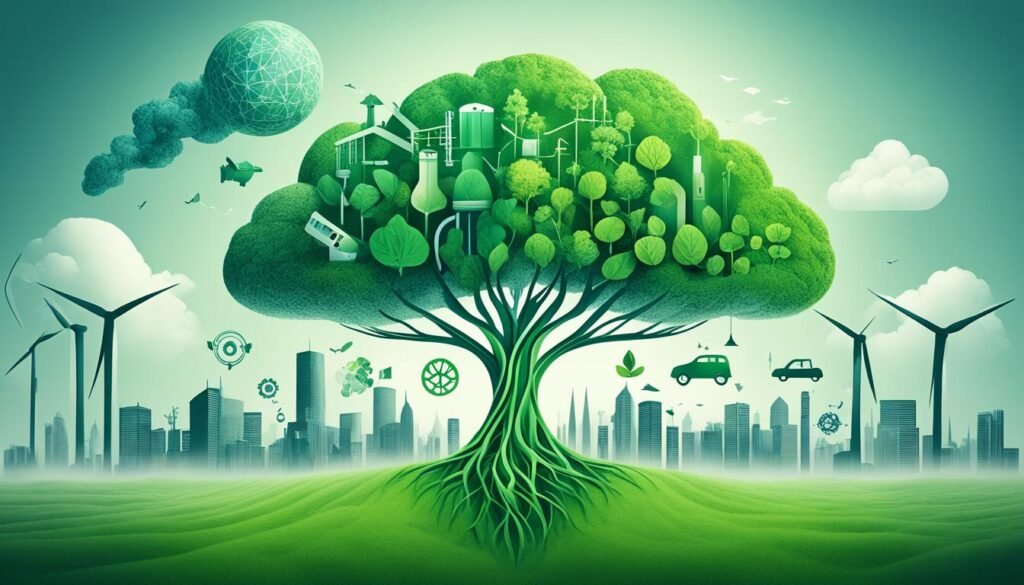
| Key Points | Description |
|---|---|
| Strategic AI Policies | Frameworks guiding responsible AI use for climate sustainability |
| Collaboration | Joint efforts of government, academia, and industry to tackle challenges |
| Investment Returns | High returns on climate-resilient infrastructure investments |
| AI in Monitoring | Utilizing AI for satellite monitoring to track climate changes |
| Renewable Energy Transition | AI helps optimize energy grids crucial for renewable energy advancement |
In conclusion, making and improving AI policies is key for governments to use AI to fight climate change. By doing this responsibly, we can find big chances for a sustainable future.
Green Innovation with Artificial Intelligence
Green innovation AI is changing how we tackle environmental issues. It’s bringing together artificial intelligence and green efforts to find new solutions. These solutions aim to fight climate change and save resources.
AI is helping companies create new ways to cut down on emissions and use energy better. For example, the Microsoft Earth project uses AI to track environmental changes in real-time. It looks at data from satellites and sensors35. Google’s DeepMind Project is also using AI to tackle global challenges, including the environment35.
AI is key in monitoring the environment. It looks at satellite images and sensor data to track deforestation, wildlife, and natural disasters. This helps speed up how we respond to crises1. In farming, AI helps use water and grow crops better, which is good for the planet1.
AI also helps make renewable energy like wind and solar more efficient. It looks at weather and energy use patterns. Google has shown how AI can cut down on energy use in their data centers by 40%, showing AI’s power1.
Using sustainable energy is exciting, especially as companies aim for sustainability and use more renewable energy33. AI helps design energy-saving buildings and plan routes for low-emission transport. This leads to greener practices in industries1.

Conclusion
AI climate solutions are key to fighting climate change. They are changing how we talk about saving the planet and protecting nature. AI helps with energy use, weather forecasts, and farming, making a big difference worldwide3637.
Investing in AI can make our planet greener. It helps use energy and resources better and reduces harm to the environment. But, we must think about AI’s own impact on the planet, like its carbon footprint36.
We need to work together to use AI for good. By using AI to make better decisions and manage resources, we can build a future that’s good for the economy and the planet and tackle climate issues38.
FAQ
How is AI being used to combat climate change?
What role does AI play in global climate initiatives?
How does machine learning contribute to environmental sustainability?
What is the importance of predictive modeling in climate science?
How does AI optimize agricultural practices?
In what ways does AI improve renewable energy systems?
How can AI help track and manage urban pollution?
What role does AI play in disaster risk management?
How is AI transforming the fashion industry?
What is AI’s impact on food security?
How does AI enhance early warning systems for extreme weather?
What role do government policies play in integrating AI for climate solutions?
How does AI promote green innovation?
Source Links
- https://greenly.earth/en-us/blog/ecology-news/how-can-artificial-intelligence-help-tackle-climate-change
- https://medium.com/@kaushikvikas/exploring-the-role-of-ai-in-climate-change-solutions-0b7b166f95a2
- https://www.linkedin.com/pulse/intersection-ai-climate-change-solutions-david-john-cummins
- https://link.springer.com/article/10.1007/s43762-023-00100-2
- https://blog.google/outreach-initiatives/sustainability/report-ai-sustainability-google-cop28/
- https://www.brookings.edu/articles/the-us-must-balance-climate-justice-challenges-in-the-era-of-artificial-intelligence/
- https://www.informationweek.com/sustainability/the-role-of-ai-in-combating-climate-change
- https://www.bezosearthfund.org/ai-climate-nature
- https://www.forbes.com/sites/bernardmarr/2024/06/04/hype-or-reality-will-ai-really-solve-climate-change/
- https://aiforgood.itu.int/about-ai-for-good/aiml-solutions-for-climate-change/
- https://ai.northeastern.edu/news/ai-for-climate-and-sustainability
- https://www.perchenergy.com/blog/innovation/artificial-intelligence-environment-sustainability
- https://mitsloan.mit.edu/ideas-made-to-matter/tackling-climate-change-machine-learning
- https://allenai.org/climate-modeling
- https://www.forbes.com/sites/forbestechcouncil/2024/07/19/taking-an-ai-approach-to-combating-climate-change/
- https://www.cutter.com/article/leveraging-ai-foster-climate-resilient-sustainable-agriculture
- https://www.rockefellerfoundation.org/insights/grantee-impact-story/an-ai-powered-app-fights-climate-change-while-revolutionizing-farming/
- https://www.kyotutechnology.com/the-role-of-ai-in-optimizing-renewable-energy-production/
- https://transcendinfra.com/ai-for-climate-change/
- https://indiaai.gov.in/article/ai-solutions-for-climate-change-solutions-for-a-greener-future
- https://www.appen.com/blog/how-ai-technology-is-revolutionizing-climate-change-mitigation
- https://www.ncbi.nlm.nih.gov/pmc/articles/PMC10280551/
- https://www.mdpi.com/2071-1050/15/23/16461
- https://gramener.medium.com/disaster-preparedness-with-ai-1a9e1ec249f0
- https://engineering.tamu.edu/news/2023/06/leveraging-big-data-and-ai-for-disaster-resilience-and-recovery.html
- https://ausbizmedia.com/how-ai-is-revolutionising-climate-action-in-the-fast-fashion-industry/
- https://www.unsw.edu.au/news/2024/05/how-ai-can-revolutionise-the-global-fast-fashion-industry
- https://aiforgood.itu.int/how-ai-can-improve-agriculture-for-better-food-security/
- https://www.food-safety.com/articles/9674-harnessing-ai-to-safeguard-food-safety-in-the-face-of-climate-change
- https://www.frontiersin.org/journals/artificial-intelligence/articles/10.3389/frai.2024.1328530/full
- https://www.ox.ac.uk/news/2024-06-25-ai-led-science-innovation-protects-communities-hit-climate-change
- https://blogs.worldbank.org/en/governance/leveraging-data-and-artificial-intelligence-climate-smart-decision-making-government
- https://environment.upenn.edu/events-insights/news/ai-and-environmental-challenges
- https://news.un.org/en/story/2023/11/1143187
- https://www.linkedin.com/pulse/green-innovation-how-ai-fighting-environmental-crisis–5mgzf
- https://www.ncbi.nlm.nih.gov/pmc/articles/PMC8522259/
- https://www.tractiontechnology.com/blog/ai-and-climate-change-pioneering-technologies-for-a-sustainable-future
- https://source.colostate.edu/how-can-ai-help-in-climate-change/


